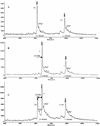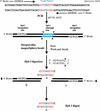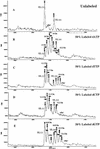Validation of DNA sequences using mass spectrometry coupled with nucleoside mass tagging
- PMID: 12097352
- PMCID: PMC186625
- DOI: 10.1101/gr.221402
Validation of DNA sequences using mass spectrometry coupled with nucleoside mass tagging
Abstract
We present a mass spectrometry (MS)-based nucleoside-specific mass-tagging method to validate genomic DNA sequences containing ambiguities not resolved by gel electrophoresis. Selected types of (13)C/(15)N-labeled dNTPs are used in PCR amplification of target regions followed by matrix-assisted laser desorption ionization time-of-flight (MALDI-TOF)-MS analysis. From the mass difference between the PCR products generated with unlabeled nucleosides and products containing (13)C/(15)N-labeled nucleosides, we determined the base composition of the genomic regions of interest. Two approaches were used to verify the target regions: The first approach used nucleosides partially enriched with stable isotopes to identify a single uncalled base in a gel electrophoresis-sequenced region. The second approach used mass tags with 100% heavy nucleosides to examine a GC-rich region of a polycytidine string with an unknown number of cytidines. By use of selected (13)C/(15)N-labeled dNTPs (dCTPs) in PCR amplification of the target region in tandem with MALDI-TOF-MS, we determined precisely that this string contains 11 cytidines. Both approaches show the ability of our MS-based mass-tagging strategy to solve critical questions of sequence identities that might be essential in determining the proper reading frames of the targeted regions.
Figures





Similar articles
-
Matrix-assisted laser desorption/ionization time-of-flight mass spectrometry for the detection of polymerase chain reaction products containing 7-deazapurine moieties.Anal Biochem. 1996 Dec 1;243(1):55-65. doi: 10.1006/abio.1996.0481. Anal Biochem. 1996. PMID: 8954525
-
Stable-isotope-assisted MALDI-TOF mass spectrometry for accurate determination of nucleotide compositions of PCR products.Anal Chem. 1999 Aug 1;71(15):3118-25. doi: 10.1021/ac9812680. Anal Chem. 1999. PMID: 10450157
-
Analysis of short tandem repeat polymorphisms in human DNA by matrix-assisted laser desorption/ionization mass spectrometry.Anal Chem. 1997 Oct 1;69(19):3966-72. doi: 10.1021/ac970312t. Anal Chem. 1997. PMID: 9322432
-
Proteome research: complementarity and limitations with respect to the RNA and DNA worlds.Electrophoresis. 1997 Aug;18(8):1217-42. doi: 10.1002/elps.1150180804. Electrophoresis. 1997. PMID: 9298643 Review.
-
MALDI-TOF mass spectrometry: a versatile tool for high-performance DNA analysis.Mol Biotechnol. 2004 Feb;26(2):147-64. doi: 10.1385/MB:26:2:147. Mol Biotechnol. 2004. PMID: 14764940 Review.
References
-
- Blackstock WP, Weir MP. Proteomics: Quantitative and physical mapping of cellular proteins. Trends Biotechnol. 1999;17:121–127. - PubMed
-
- Chen X, Fei Z, Smith LM, Bradbury EM, Majidi V. Stable-isotope-assisted MALDI-TOF mass spectrometry for accurate determination of nucleotide compositions of PCR products. Anal Chem. 1999;71:3118–3128. - PubMed
-
- Fei Z, Smith LM. Analysis of single nucleotide polymorphisms by primer extension and matrix-assisted laser desorption/ionization time-of-flight mass spectrometry. Rapid Commun Mass Spectrom. 2000;14:950–959. - PubMed
Publication types
MeSH terms
Substances
LinkOut - more resources
Full Text Sources
Other Literature Sources
Miscellaneous
